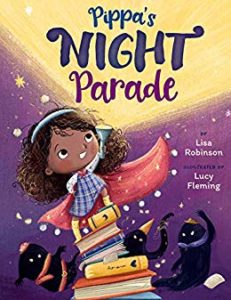 Pippa’s Night Parade
Pippa’s Night Parade
Author: Lisa Robinson
Illustrator: Lucy Fleming
Two Lions
8 October 2019
32 pages
This month’s PB review is by Ryan G. Van Cleave (#1 parade aficionado at Only Picture Books) and Ringling College of Art and Design Illustration Professor (and OPB buddy) David C. Gardner.
–Ryan’s Review of the Writing–
Pippa has a problem–a “wonderfully wild imagination” that sometimes “runs a little TOO wild.” She does just fine at day when her various costumes serve as armor, but come nighttime? She worries about “villains and monsters and beasts.” Indeed, they pour forth from the darkest corners of both her imagination and her bedroom to cause grief.
Pippa finally tries to tackle her fears head-on through an invitation to all monsters to come out that night for the Scary Night Parade. Her hope is to deal with the lot of them, once and for all. Yet it doesn’t work out as she hoped. But Pippa refuses to quit. Her next attempt to deal with the monsters leverages something she’s loved from the start–fashion. She’s a big fan of dress-up. When she brings out the “sashes and sequins and bows” and “belts and berets and shawls,” the critters get into the fashionista spirit and participate in the spectacular show.
Robinson wisely doesn’t let the parents save the day (they quite reasonably send Pippa back to her own bed “again and again and again”). She also presents Pippa as being able to overcome her greatest weakness/fear through the use of an existing strength. That’s an empowering thing for kids to consider.
Pippa becoming the leader of the monster pack feels like a quiet nod toward Where the Wild Things Are, too, though it’s a bit unfair to compare any book to Sendak’s nuanced masterpiece.
Many readers will delight in Robinson’s attention to the repetition of sound, such as “designs a disguise” and “beasts and brutes and baddies.” They’ll likely enjoy the presentation of Pippa, as well, since she’s a plucky dark-haired girl who uses her imagination plus problem-solving skills to get past a common childhood issue.
The well-wrought cartoony illustrations help bring it all together and keep this story more fun than frightening.
4 out of 5 pencils
– David’s Review of the Illustrations–
A light in the darkness.
It starts with the cover: Pippa, victorious, wields a flashlight. Banishing fears with light is the major motif that illustrator Lucy Fleming finds to bring this minimal text to life. It’s a lovely, visual way to capture Pippa’s solution to her bedtime fears.
Along the way, Fleming has plenty of room to add playful touches, like adding a cute white cat (notice: not a scary black Halloween cat!) who accompanies Pippa, like a witch’s “familiar.” The palette is perfect for Halloween, lots of violet, starting with the end papers, complemented with yellow throughout.
This book is clearly aimed at a very young crowd. The pictures are mysterious without being too scary, with plenty of humor, action, and movement. Her monsters early on take the form of ghostly shadows, in one especially clever extension of the text, unscrewing the lightbulbs over Pippa’s bed when she “tries extra nightlights.”
Pippa’s whimsical answer to defeating the monsters? Dress them in silly costumes. That whimsy is echoed in Fleming’s loose, sometimes flattened style, colorful and bright, even at their spookiest, bringing to mind the way a child might draw and color the action.
It would be a mistake, though, to dismiss Fleming’s pictures as naïve. She draws Pippa as a big-headed kid in the style of the great Mary Blair, a Disney stylist from the 40s through the 60s (think “It’s a Small World”). Blair’s approach is much imitated in picture books today. Fleming even mimics Blair’s gouache painting style, except her opaque watercolor and colored pencil is all created digitally. She manages to bring to it a texture and warmth that feels made-by-hand.
The neatest trick of all: The text moves in and out of Pippa’s mind as her real world intersects with her imagination. To a very young child, there’s not much difference between the two worlds. Fleming blends them, painting a vivid picture of Pippa’s inner and outer landscape, drawing us into the story more deeply than the text alone could manage.
This is a simple story, but a difficult, archetypal one in a child’s development. Fleming manages to help it all go down like Halloween candy.
4 out of 5 crayons

David C. Gardner is an award-winning illustrator and visual development artist. A former artist for Walt Disney Animation Studios, he has illustrated numerous picture books, including his latest from Sleeping Bear Press,
Write On, Irving Berlin! by Leslie Kimmelman (
which appeared on OPB not so long ago). It tells the true story of little Izzy Baline, who immigrated to New York City in 1893 and grew up to become Irving Berlin, one of the most well-known composers of popular music in America. David teaches illustration at
Ringling College of Art and Design.
All at Once Upon a Time
 Don’t Invite a Bear Inside for Hanukkah
Don’t Invite a Bear Inside for Hanukkah Nocturnal Nico: A Bedtime Picture Book for Night Owls
Nocturnal Nico: A Bedtime Picture Book for Night Owls Oak: The Littlest Leaf Girl
Oak: The Littlest Leaf Girl



 David C. Gardner is an award-winning illustrator and visual development artist. A former artist for Walt Disney Animation Studios, he has illustrated numerous picture books, including his latest from Sleeping Bear Press,
David C. Gardner is an award-winning illustrator and visual development artist. A former artist for Walt Disney Animation Studios, he has illustrated numerous picture books, including his latest from Sleeping Bear Press,